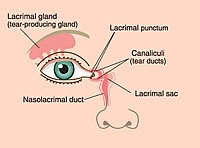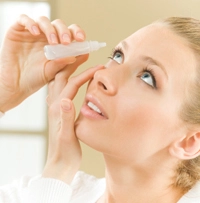Tearing

 In order for the eye to function properly, it must be kept well lubricated. Accordingly, there is an extensive system of glands that produce different components of the tears that work together to form a functional tear film. This tear film is crucial to protecting the delicate surface of the eye, keeping the eye comfortable, and maintaining crisp vision. However, if there are too many tears covering the eye, this can cause significant problems. Patients with excess tearing will often notice: blurred vision, constant tears streaming down the face, redness and skin irritation from constant dabbing of tears, and recurrent infections.
In order for the eye to function properly, it must be kept well lubricated. Accordingly, there is an extensive system of glands that produce different components of the tears that work together to form a functional tear film. This tear film is crucial to protecting the delicate surface of the eye, keeping the eye comfortable, and maintaining crisp vision. However, if there are too many tears covering the eye, this can cause significant problems. Patients with excess tearing will often notice: blurred vision, constant tears streaming down the face, redness and skin irritation from constant dabbing of tears, and recurrent infections.
The exact cause for the excessive tearing can sometimes be difficult to elicit. This problem can occur if there is an overproduction of tears, decreased drainage of tears, or a combination of the two.
Overproduction of Tears
Overproduction of tears may be related to several ocular conditions that will signal your tear gland (lacrimal gland), to produce extra tears. Causes include:
- Dry eyes
- Allergies
- Ocular surface irritation
- Infections
- Eyelid inflammation (blepharitis)
The aforementioned conditions can be treated with artificial tears, allergy drops, anti-inflammatory drops, antibiotic drops or ointments, and oral medications.
Decreased Drainage
Each eyelid has two small openings (puncta), one on the upper lid and one on the lower lid, that lead into a drainage system, which will empty into a sac (lacrimal sac) that ultimately passes through a duct (nasolacrimal duct) into the nose. Anatomic variations at any point along this passageway can cause excess tearing. In addition to tearing, a blockage along the drainage system can cause recurrent infections. Symptoms of these infections include warmth and redness in the area in between the eye and nose, purulent discharge, and a pink irritated eye.
Blockage of the tear drainage system can be confirmed by performing a small non-invasive test in the office where a salt solution is irrigated through the tear drain. Depending on the results, corrective options can be discussed. Options to improve drainage may be as simple as starting a regimen of steroid drops, but in certain cases, surgery may be the best option.

